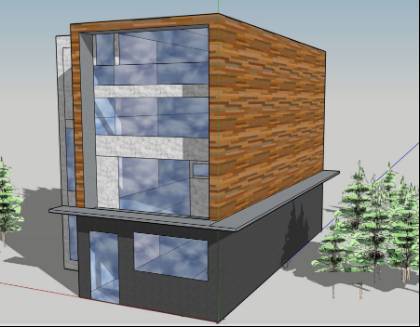
Concerned about the increased need for affordable housing following last summer's California wildfires, Dani Murphy felt inspired to find a solution.
A senior this past semester at the Jerry S. Rawls College of Business, Murphy knew that people had successfully built "tiny homes" out of shipping containers, which hold cargo on ships. She wondered if this low-cost construction material could be used to build homes on a broader scale.
"I thought it would be neat to provide housing for people as a relief measure after I learned people were dislocated from their homes because of the wildfires in California last summer," said Murphy, who on Saturday earned her Bachelor of Business Administration with a concentration in finance.

As she thought more about the concept, her intended group of potential beneficiaries grew to include not only those displaced by disaster, but those wanting a vacation home.
"I thought it would be nice if people could buy an elevated level of living that they didn't have before but for the same price that they were already paying for their home, or for less," she said.
Last fall, she shared her thoughts with Jared Harrell, an assistant professor of practice in the Area of Finance, and embarked this spring on a semester-long independent study project under his guidance to evaluate the financial feasibility of constructing luxury homes made from shipping containers.
Murphy recently presented her findings at Rawls College to faculty members and others, including a representative of the South Plains Association of Governments.
"I'm very proud of her work," Harrell told attendees of her presentation as he introduced her.
Murphy shared with attendees a hypothetical example of a luxury two-story home constructed in Breckenridge, Colorado, using shipping containers. In analyzing the construction costs and market, she found that these types of homes could be built for about $150,000, which is about $40,000 to $50,000 below the cost of a ground-up build, she said.
A used shipping container that is 8 feet by 40 feet runs about $2,500, is rust-resistant, and has a lifespan of about 7 to 15 years, depending on whether they are made of steel or aluminum and what coatings they might have, she said.
"Building with container homes is affordable. You don't have to sacrifice quality," she said.
For real estate developers and investors, that translates to profitability, which will inevitably result in more of these homes available on the market.
"This will allow more households to obtain a higher quality home or potentially give them the ability to own a second home," she said.
She also likes the recycling aspect of turning old, retired shipping containers, which would otherwise be left to rust and become eyesores, into beautiful homes.
She found that welding the containers together in the construction process saves money.
"Thirty to fifty percent of the schedule is cut down, and that's the value driver," she told her audience.
Shipping containers have some limitations, she acknowledged.
"The more you cut and dissect the containers, the more expensive it gets, and then you can no longer compete on the price portion of it. So that's something that we've been finding," Murphy said. "But we would still be able to provide pretty impressive homes nonetheless."
Stephen Buschbom, an assistant professor of finance, was also among those who attended her presentation and found her study about container homes intriguing.
"I've been interested in these for eight years," he told Murphy.
Attendee Kelly Davila, regional services director for the South Plains Association of Governments, mentioned the lack of affordable housing in rural areas.
"The affordability aspect is the issue for housing needs in rural areas, so it's very interesting," Davila said of Murphy's presentation.
Though Murphy will begin working this summer at Bloomberg BNA in Washington, D.C., she intends to apply her newfound knowledge about shipping container homes at some point in the near future by overseeing the finance and construction of them, starting with a "tiny home" in the next few years.
"It's been fun to study," Murphy said, "and I do think that someday we're going to be able to bring these homes to people who need them."
